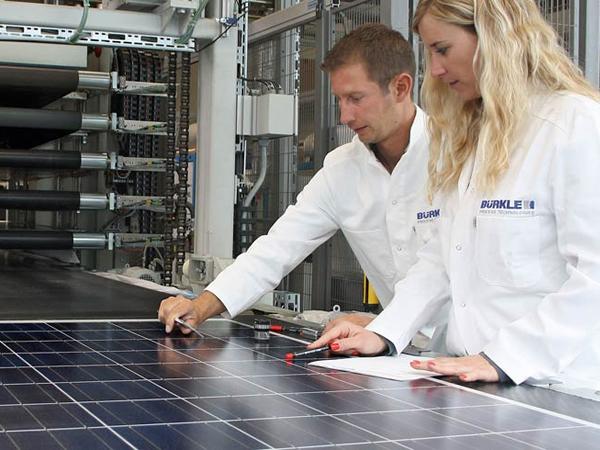
By Nikolaus Fecht
In 2015, VDMA assumed responsibility for the ITRPV, which provides the photovoltaic industry with an overview of how the technologies will develop on an annual basis over the next ten years.
This forecast is utilized by important mechanical and plant engineering companies around the world as well as by cell and module manufacturers and many research institutions.
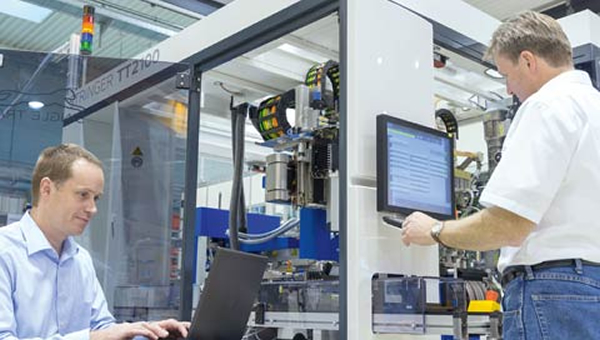
Optical inspection improves quality
The roadmap is of great importance to Richard Moreth, Sales Director Photovoltaic (PV) at Vitronic Dr.-Ing. Stein Bildverarbeitungsysteme GmbH in Wiesbaden. The expert has worked in the photovoltaic industry for over a quarter of a century and has not only made use of the roadmap for several years but also fills it with information.
Moreth is particularly interested in trends regarding quality improvement using automated optical inspection (AOI). "Some customers use ten or more camera systems for just a single line," the expert observes. "In addition to using AOI for their final inspections, they can also use it to monitor processes and thus increase the throughput and percentage top-grade products."
Recognizing trends - Adjusting systems
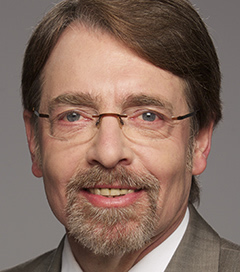
Since Moreth works on many sections of the roadmap, he implements many suggestions in advance. Information on wafer development is of particular importance for the provider of vision systems.
"It is important for us to know which direction trends will take, so we can adjust our systems accordingly using algorithms and sensors," explains the long-term expert, adding: "This is the only way we can develop the inspection equipment of the future today."
The Hessian company particularly focuses on the development of innovative, user-friendly in-line inspection solutions, which are superior to the competition in terms of error detection and classification. Comprehensive analysis tools detect process deviations immediately and enable direct process optimization.
Responding with high quality
Vitronic has an ambivalent relationship with low-cost foreign companies. On the one hand, the company provides high-quality image processing systems with which users can produce more products in top-grade quality.
These systems enable the company from Wiesbaden to stand up to the international competition more easily. On the other hand, the company enables Far Eastern suppliers to produce high-quality PV products at low costs.
Using the roadmap strategically
"I have been observing the roadmap for a while and for three years now I have been using it strategically," says Christian Probst, Managing Director at the Isra Vision AG in Darmstadt. "Since there are many crucial technological changes in the solar sector, it is very important to keep an eye on how the leading companies evaluate these trends."
In Darmstadt, the company produces complete, turnkey optical inspection solutions for quality control in the solar and photovoltaic industry. For the Hessian company, four core issues surrounding solar technology are of particular importance.
- How is the percentage of mono and multicrystralline wafers developing?
- How fast is the development?
- Do companies who only focus on one of these two technologies have any trouble?
- How quickly can new cell concepts take root?
"Closely studying the ITRPV allowed us to develop new products in a targeted manner and place them on the market in time," explains Probst, adding: "Currently, we are working on the topic of back-contact solar cells, for which we have already successfully established ourselves."
Low-cost suppliers on the rise
Isra Vision, a spin-off of the TU Darmstadt, distinguishes itself with its ongoing technological development. Due to this constant process, the company does not yet feel the high pressure from low-cost suppliers as other companies in the sector do. The emphasis being on "not yet", says Probst, since the competition is becoming more intense.
The company strives to offer technologically sophisticated solutions in order to stave off new suppliers. "With better software, we enable the user to closely examine the quality of products, even under fluctuating production conditions. Here, it is important to have a truly automated surface inspection that does not require a human operator," says Probst. This solution is considerably different from many solutions from Asia which are still operated by employees.
Using roadmap tips selectively
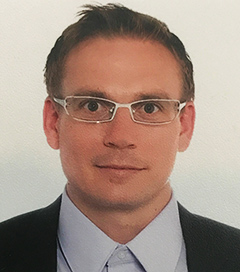
The Robert Bürkle GmbH from Freudenstadt has been making use of the roadmap for about five years.
"The developments of wafer cells and modules are always interesting for us, since they give us an indication on which changes we as mechanical engineers must prepare for," explains Michal Essich, Sales Director Photovoltaic at the company.
"However, these tips merely provide indications. We only partially implement them as described in the roadmap."
Among other things, the ITRPV included trends such as thinner wafer, glas-glas modules, new materials, cells with higher efficiency and machines with higher throughputs. "The roadmap includes many useful suggestions which provide us with orientation," says Essich, describing the practical benefit of the roadmap.
Bürkle also uses the new technologies to develop products with better Total Cost of Ownership (TCO) for its customers. The company aims to stand up against low-cost suppliers even more strongly on the world market. "The ITRPV suggestions helped us remain in the lead in terms of technology," the sales director reports.
The timing of the development must be right
"However, we took many steps prematurely which put us far ahead of the market," says Essich in retrospect, adding: "Yet, certain system features did not provide the desired effect since the development of thinner wafers was delayed by deteriorating prices of silicon." Bürkle included the developments in its systems too soon which increased the costs. The customers could not see the actual cost benefit due to the lag caused by the decline in prices.
Early start pays off
Since then, Bürkle has been working on the developments described in the ITRPV. "Now our systems are in a very good position with regard to thin wafers and glas-glas modules since we have already completed the necessary developments," explains Essich. The competition with low-cost suppliers is thus easier since they had not yet taken action in this area.
Particularly interesting for teamtechnik Maschinen und Anlagen GmbH from Freiberg on the Neckar is the information on soldering systems (stringers) provided in the roadmap. Stringers serve to solder solar cells in the solar module production chain.
"As a manufacturer of stringers, the roadmap information helps us with new materials and cell technology, joining processes, the price development of materials and modules as well as wafer strength," explains Sven Kramer, Vice President Sales Solar Technology, in detail.
The Swabian company closely observes the development in the amount of busbars and connectors processed in stringers. The roadmap had also predicted the trend towards slimmer connectors, which is why a customized system concept was developed in Freiberg.
Improved stringer systems
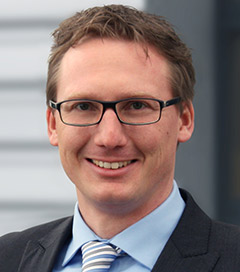
"The feedback provided by module manufacturers in the ITRPV were an enormous help to us," summarizes Kramer.
"We could thus begin planning systems starting out with four connectors early on. Today our current stringer systems process solar cells with up to six connectors," enthuses the vice president. According to him, teamtechnik was the first manufacturer to offer that.
In addition, the company developed a stringer with adhesive technology for joining heterojunction solar cells. In heterojunction technology (HJT), several layers of amorphous, non-crystalline silicon are applied to wafers made of crystalline silicon.
Companies can use this technology to manufacture solar cells with extremely high efficiency and a high energy yield on an industrial scale. Teamtechnik joins HJT solar cells at low temperatures using an electrically conductive adhesive and a structured connector.
New technologies are used methodically in Freiberg, one example being the new high-performance stringer that has an annual production performance of 130 megawatt peak while only taking up 15 square meters.
"The high system throughput is a unique selling point," emphasizes Kramer. According to him, solar module systems are increasing in size and taking up more and more space.
A system that only needs little space and reduces investment costs in infrastructure has a clear advantage. "This development was also predicted by ITRPV early on," says Kramer, evaluating the roadmap.
Roadmap supports argumentation
Dr. Oliver Voigt, Head of Sales & Products at the RCT Solutions GmbH in Constance, says: "We have used the roadmap from the start." The company uses it to support its argumentation, to explain new technologies to the customers and convince them of "getting on board."
Currently, the company is interested in multicrystalline wafers cut with diamond wire. They have a large cost-saving potential and significant influence on the subsequent manufacturing technology.
However, RTC Solutions also started working on the passivated emitter rear cell. With this efficient technology, the backside of the solar cell is also passivated. "Both sides of the cell are passivated so no open bonds can destroy charge carriers," Voigt explains.
Cost development for new technology
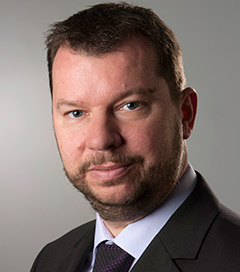
The company uses the roadmap intensively in order to offer technology projects and calculate their costs. These are new processes that often take another two years to go into serial production.
"This particularly pertains to cell technology," says Voigt, adding: "For example, estimating how the new technologies will affect manufacturing costs." This forecast focuses more on the technology than the market situation according to Voigt.
However, having a technological edge is only one way to compete with inexpensive suppliers from abroad. For that reason, RTC Solutions uses a concept that has also proven successful for other companies.
The company designs production systems for wet chemistry including the entire manufacturing process and then manufactures them with a joint-venture partner.
Roadmap is a trend barometer
The mechanical engineering company Singulus Technologies AG from Kahl on the Main has been using the roadmap since 2010. For the development manager Dr. Peter Wohlfart, several trends of the 2016 roadmap are very interesting and useful. He sees the roadmap as "a comprehensive trend barometer of photovoltaic mechanical engineering."
This includes price developments, market trends for wafer materials and cell technology, the throughput of production systems and the trends in single processes such as texture, polishing, coating as well as the developments in efficiency.
"For us, the roadmap is less of a source of advice and more of a compass," Wohlfart explains. He uses it to deduce which machine types will be in demand in the future. The company sees it as a form of confirmation when other mechanical engineering companies judge certain developments the same way.
Singulus is particularly interested in how the company implements the requirements on the machine such as throughput, wafer thickness, process variations and target costs. Wohlfart values the roadmap for its grounded and industry-oriented approach to current topics and trends.
"I have also been using the technology trends described in the roadmap for years for marketing and sales purposes," adds Bernhard Krause, Head of Corporate Communication at Singulus. "In this regard, VDMA serves as a source with good references," praises Krause. He also uses the data as an illustration for shareholders and for detailed customer meetings.
Partnerships are key
The roadmap aids Singulus in competition, particularly with foreign companies. The company supports the close cooperation with international key customers and German institutions. "We need partners because we must understand the entire process," says Wohlfart.
When it comes to crystalline silicon solar cells, the company delves deeply into mechanical engineering and process engineering as well as into the cell and material properties in order to continuously improve components and processes.
"In the very individual and complex processing steps in thin-film photovoltaics, we primarily focus on machine-oriented topics such as production costs, stability, layer and temperature distribution or improved cleaning and maintenance concepts," concludes Wohlfart.

